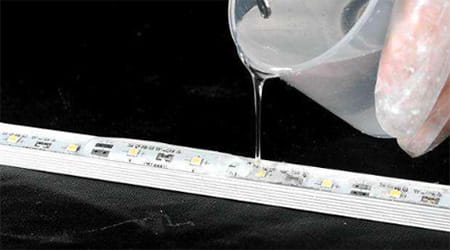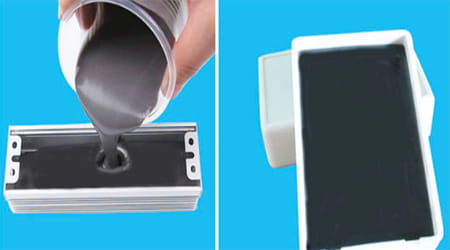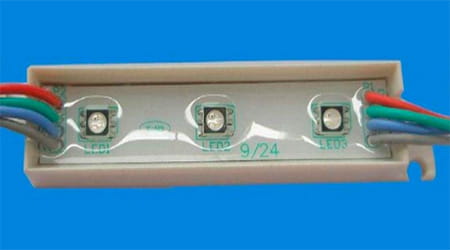What factors will affect the defoaming effect of silicone potting compound
 Mar 25,2024
Mar 25,2024

 Hanast
Hanast
In the application process of potting adhesive, most users have a defoaming process to ensure that there are no bubbles or pores inside or on the surface of the gel after the product is cured, which affects the product's performance. Many people may think that defoaming is a simple operation, and opening the vacuum box can be enough. Today, Schneider will talk to the majority of users about the consequences of not doing this simple defoaming process well and how to prevent abnormal defoaming of silicone potting compounds.
silicone potting compounds are applied to various industries after curing, including electrical and electrical engineering, military electronics, aerospace, communication equipment, automotive electronics, and so on. All industries are particularly concerned about its performance, such as electrical performance, seismic and pressure resistance, shrinkage and expansion, waterproof and water absorption, sulfur and alkali resistance, etc. If the vacuum defoaming of organic silicon sealant is not done properly in the previous process before curing, there will be bubbles inside or outside the colloid, especially bubbles inside the colloid, which are not found after curing, resulting in a decrease in the original performance of organic silicon sealant, leading to abnormal terminal products, slight rework, time-consuming and labor-intensive costs, and in severe cases, it will be directly scrapped. This is the inability to complete the final process before curing of organic silicon sealant. It is necessary to propose preventive measures to avoid risks at process nodes due to the positive consequences. The specific influencing factors are as follows.
1、 Vacuum degree
The degree of vacuum is determined by both the power of the vacuum pump and the overall airtightness. As the service life of the vacuum pump increases, some parts will age and wear out, the working power will greatly decrease, and the suction force will also decrease. Regardless of the structure of vacuum defoaming, there will be air ducts connected, and air duct joint leakage or slight damage to the air duct can also lead to insufficient suction force. Therefore, inspection and maintenance of equipment should be carried out regularly as daily work, including the sensitivity of the vacuum gauge. If the vacuum gauge is not a standard product, the sensitivity is low, and the continuous display of normal is also a potential work risk.
2、 Defoaming process
There are two types of vacuum defoaming boxes, one is manual control, and the other is program control. The phenomenon that is prone to occur during the defoaming process is overflow and the bubbles are difficult to break and dissipate. Overflow usually occurs in products with little or full glue filling. For such products, manual control boxes cannot directly pump at -0.1Mpa. It is necessary to observe and reduce the vacuum degree when the rubber block is fully removed. Repeat the operation, or reduce the vacuum degree to -0.08-0.09Mpa when vacuuming in the previous stage. Slowly pump some points on the surface and upper layer, and then use -0.1Mpa to pump when unable to move, so as not to overflow; The use of program control is relatively limited. If it is a glue manufacturer, it is not recommended to use it. The viscosity, density, defoamer, etc. of different glues are different, and cannot correspond to the same program. Therefore, each defoaming process needs to be adjusted. Schneider learned that some users of silicone sealant use program-controlled vacuum defoaming boxes, and the glue used is single. As long as the manual defoaming time and vacuum degree programming defoaming program of silicone sealant is used, it can meet production needs. The requirements for program defoaming boxes are relatively high, and differences in viscosity, density, or other aspects of the sealant will be reflected in the defoaming process. Therefore, for some users who use automatic defoaming boxes, on-site assistance will be provided. Set up the procedure for this process.
Of course, there are also factors related to the adhesive itself. For manufacturers, the factors that affect the defoaming performance of silicone potting compounds in the research and development, and optimization process include density, viscosity, performance, and dosage of defoamers. Because mature silicone potting compound products have the function of self-defoaming, they are easy to defoam. Therefore, users need to manage and optimize their equipment and processes to prevent product abnormalities caused by bubbles. As a professional manufacturer of silicone potting compounds, Schneider has the ability and responsibility to assist users in solving any adhesive process problems in all aspects. Therefore, when using silicone sealant, Schneider is chosen for more comprehensive service.




 Home
Home




 Addition silicone gel
Addition silicone gel  You May Also Like
You May Also Like







 Tel
Tel
 Email
Email
 Address
Address












